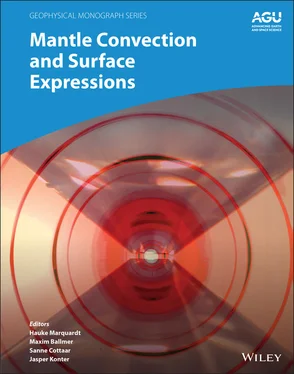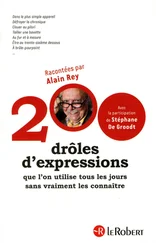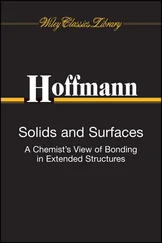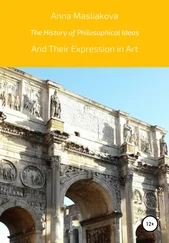2.5.3 Texture Development in Polyphase Materials
Texture development in polyphase materials is also complex. Experimental texture studies in polyphase earth materials are fairly limited, however, in material science deformation and texture development in composites has been studied more extensively. The following discussion will focus on composites with large strength contrasts, as this is more relevant to the discussion of lower mantle aggregates. One class of materials that have a large strength contrast is metal matrix composites. These materials are composed of a ductile metal matrix that has been reinforced with hard carbides, borates, or oxides and thus present a composite with a large strength contrast. It is commonly observed that the inclusion of hard particles results in modification of texture type or a reduction in texture strength in the metal matrix (e.g., Garcés et al., 2005, 2006; Poudens et al., 1995; S. C. Xu et al., 2011; Zhang et al., 2004). In these materials, high strength particles induce complex strain fields around these nearly undeformed inclusions, resulting in texture strength reduction in the metal matrix. In Al+SiC composites, SiC concentrations >10% show decreased texture strength in the Al matrix (Poudens et al., 1995; Zhang et al., 2004). Likewise Garcés et al. (2006) found that in Mg+Y 2O 3composites, the addition of yittria particles lowers texture strength in the softer Mg phase due to complex deformation patterns around the hard ceramic particles. In aluminum borate reinforced 6061 aluminum alloy, texture development in the aluminum matrix is quite different when compared to pure phase 6061 alloys (S. C. Xu et al., 2011). These cases are extreme examples where the hard phase does not deform and so the matrix must flow around the particles. A less extreme example is a study on extrusion of Al‐Pb composites containing 20%, 40%, 60%, and 80% volume fractions of Al (Brokmeier et al., 1988). This study found that in both phases, increasing the volume fraction of a phase resulted in a decrease in texture strength of the other phase. The texture decrease in the harder Al phase is attributed to increased strain partitioning into the softer phase (i.e., there is less internal deformation of Al grains as the volume fraction of Pb increases). In the softer Pb phase, the decrease in texture strength with addition of Al is attributed to heterogeneous strain induced in the Pb phase by the hard Al grains. The authors term this effect “turbulence of flow” (Brokmeier et al., 1988). These studies consistently show that in composites with large strength contrast, texture reduction, or significant texture modification in the softer phase is linked to deformation heterogeneity in regions adjacent to the harder phase. In particular, stronger particles generate complex deformation geometries in surrounding regions, disrupting coherent texture formation in the softer phase.
In earth science, crustal and upper mantle materials can exhibit similar behaviors. Handy (1994) notes in his discussion of IWL behavior that there is large stress, strain, and strain rate heterogeneity in regions surrounding hard feldspar grains in naturally deformed quartz feldspar mylonites, but texture measurements were not reported. In quartz + mica aggregates, the addition of rigid micas has been shown to reduce texture strength in the quartz phase both in simulations and experiments (Canova et al., 1992; J. Tullis & Wenk, 1994). Bystricky et al. (2006) studied deformation of olivine + (Mg 0.7Fe 0.3)O as an analog for polyphase mantle rock. This sample contained 20% olivine and was deformed in dislocation creep to very high shear strains of γ ~15 in a gas media apparatus. In these experiments, the majority of the strain was partitioned into the Fp matrix but olivine grains did deform and developed texture. Although the Fp phase did texture, the texture patterns of the Fp differed significantly from previous single phase experiments (Heidelbach et al., 2003; Yamazaki & Karato, 2002). These anomalous textures were attributed to local heterogeneity in flow geometry adjacent to the olivine clasts (Bystricky et al., 2006). Similar to the behavior of metal composites, these studies show that large differences in rheological properties between two phases in an aggregate can result in heterogeneous deformation even with relatively small amounts of the harder phase. Likewise, in earth materials heterogeneous deformation of the softer phase can result in significantly modified textures and/or randomization of the softer phase.
2.5.4 Texture Development in High Pressure Studies of Polyphase Aggregates
Similar trends in polyphase texture development are also observed in high‐pressure studies. When Brg + Fp are deformed together in the DAC, Fp does not develop significant texture (Miyagi & Wenk, 2016; Wenk et al., 2004; Wenk, Lonardelli, et al., 2006) ( Figure 2.7). In these materials, weaker Fp is expected to accommodate the majority of strain (Girard et al., 2016), but in contrast to metal matrix composites and studies on quartz + mica and olivine + Fp aggregates the harder bridgmanite phase is volumetrically dominant. This behavior is similar however to Al+Pb where textures in Pb become nearly random at larger volume fractions of Al (Brokmeier et al., 1988). Similarly, in two‐phase aggregates of NaMgF 3Pv + NaCl deformed in the D‐DIA at a range of strain rates, temperatures and phase proportions, NaCl does not develop significant texture while the stronger NaMgF 3phase does (Kaercher et al., 2016). These materials have large strength contrasts of ~10 and this behavior is observed over a wide range of phase proportions (NaCl = 15–70%). Microstructural analysis using synchrotron tomography and scanning electron microscopy shows that although texture development in this phase is weak, the majority of the strain partitions into NaCl. Plasticity modeling indicates that local stress–strain heterogeneities caused by grain‐to‐grain interactions between the Pv phase and the NaCl phase result in a randomization of the NaCl phase (Kaercher et al., 2016), consistent with polyphase texture studies at lower pressures (Brokmeier et al., 1988; Canova et al., 1992; Garcés et al., 2006; Poudens et al., 1995; J. Tullis & Wenk, 1994).
In contrast to experiments on Brg + Fp in the DAC and NaMgF 3+ NaCl aggregates in the D‐DIA, D‐DIA deformation experiments on CaGeO 3+ MgO do observe texture development in MgO (Y. Wang et al., 2013). Notably the strength contrast between CaGeO 3and MgO (~2) is significantly lower than NaMgF 3and NaCl (~10) and similar or lower than Brg and Fp (~1.4‐4). This discrepancy may due strength contrast but also to the degree of anisotropy of the Pv phase. Both Brg and NaMgF 3are orthorhombic and exhibit a dominant slip plane that has no additional symmetric variants (of the plane). In Brg the dominant slip plane at room temperature appears to be (001) (e.g., Cordier et al., 2004; Miyagi & Wenk, 2016; Miyajima et al., 2009) or (100) at higher temperatures (Tsujino et al., 2016). In NaMgF 3Pv the dominant slip plane appears to be (100) (Kaercher et al., 2016). Thus, plastic anisotropy of these phases is relatively high. In contrast, CaGeO 3is close to cubic (pseudo‐cubic) and deform predominantly on the {110}〈1  0〉 slip system. This slip system has six symmetric variants and so plastic anisotropy is much lower than for Brg and NaMgF 3Pv. Thus, it is likely that the degree of plastic anisotropy of the harder phase plays an important role in controlling texture development in the softer phase. The modeling of Kaercher et al. (2016) shows that highly anisotropic NaMgF 3Pv grains impinge on NaCl grains and cause heterogeneous local stress‐strain fields around the soft NaCl grains. This causes the local stress–strain field to deviate from the macroscopic field, and since this varies from grain to grain, the NaCl phase does not develop “coherent” texture.
0〉 slip system. This slip system has six symmetric variants and so plastic anisotropy is much lower than for Brg and NaMgF 3Pv. Thus, it is likely that the degree of plastic anisotropy of the harder phase plays an important role in controlling texture development in the softer phase. The modeling of Kaercher et al. (2016) shows that highly anisotropic NaMgF 3Pv grains impinge on NaCl grains and cause heterogeneous local stress‐strain fields around the soft NaCl grains. This causes the local stress–strain field to deviate from the macroscopic field, and since this varies from grain to grain, the NaCl phase does not develop “coherent” texture.
Читать дальше

 0〉 slip system. This slip system has six symmetric variants and so plastic anisotropy is much lower than for Brg and NaMgF 3Pv. Thus, it is likely that the degree of plastic anisotropy of the harder phase plays an important role in controlling texture development in the softer phase. The modeling of Kaercher et al. (2016) shows that highly anisotropic NaMgF 3Pv grains impinge on NaCl grains and cause heterogeneous local stress‐strain fields around the soft NaCl grains. This causes the local stress–strain field to deviate from the macroscopic field, and since this varies from grain to grain, the NaCl phase does not develop “coherent” texture.
0〉 slip system. This slip system has six symmetric variants and so plastic anisotropy is much lower than for Brg and NaMgF 3Pv. Thus, it is likely that the degree of plastic anisotropy of the harder phase plays an important role in controlling texture development in the softer phase. The modeling of Kaercher et al. (2016) shows that highly anisotropic NaMgF 3Pv grains impinge on NaCl grains and cause heterogeneous local stress‐strain fields around the soft NaCl grains. This causes the local stress–strain field to deviate from the macroscopic field, and since this varies from grain to grain, the NaCl phase does not develop “coherent” texture.










